
When you need to create an online registration form, Microsoft Forms can be a useful and simple tool. It’s included with Microsoft 365 subscriptions and allows you to create forms quickly for events, classes, and surveys.
In this guide, we’ll walk you through the process of creating a registration form using Microsoft Forms and discuss its benefits and limitations.
We will also discuss some of the limitations of Microsoft Forms, particularly when it comes to online registration for classes, activities or events, as well as alternatives that may be more appropriate for certain situations or types of registration forms.
Author’s note: Olivier is the co-founder of Activity Messenger & shares tips and tricks that have helped hundreds of dance studios, gymnastics clubs, swim schools, Soccer Academies and camps design mobile-friendly registration forms that streamline operations and increase revenue.
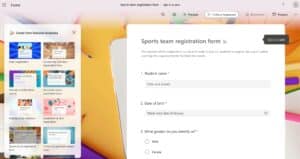
For full functionality, especially if you want to create professional forms with advanced features, a Microsoft 365 subscription is recommended. Some free features might be limited in scope, so check what is available depending on your subscription.
Once you’ve accessed Microsoft Forms, creating a new form is straightforward. Here’s how you can get started in more detail:
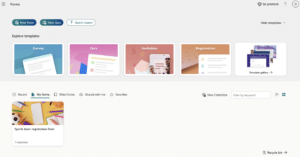

By setting a clear title and providing a relevant description, you ensure participants immediately understand the purpose of the form and feel confident proceeding with the registration process.
This is the core of your registration form. Microsoft Forms offers a variety of question types that allow you to collect the specific information you need:
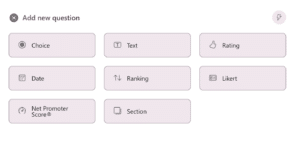
When adding questions, think carefully about the data you need. For registration forms, typical questions include name, email, phone number, event/session preference, and any special requests. You can customize each question to require an answer or set restrictions.
An online registration form builder like Activity Messenger allows you to create multiple classes with attendance list, waitlist automation, online payments and much more.
Customizing your registration form helps ensure that it looks professional and is aligned with your brand. Microsoft Forms provides some basic customization options:
While the customization options are somewhat limited in Microsoft Forms, these basics ensure the form is still functional and visually appealing.
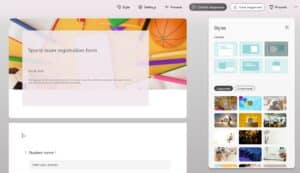
Note: Some of the features that are not available in Microsoft Forms, but are very important when collecting online registrations, are the ability to accept terms and conditions, to digitally sign a liability payment, and to securely pay for the class, camp or activity.
Setting restrictions helps guide participants in providing the right information. For instance:
Tailoring the settings to your organisation’s needs will improve the quality of responses and ensure that you collect the information you need without errors.
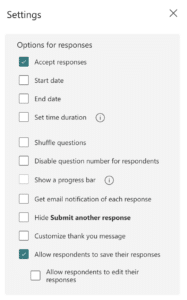
Once you’ve added all your questions and customized your form, it’s essential to test it before sending it out. Microsoft Forms offers a Preview option, allowing you to see the form as your participants will. Take the time to fill out the form yourself to ensure everything works as expected, from answering the questions to submitting the form.
Testing is crucial because even a small mistake can cause confusion for respondents or lead to incomplete registrations.
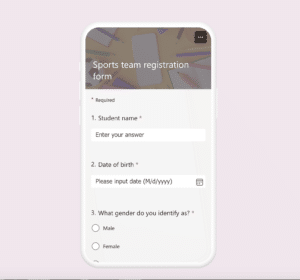
Once your form is live, Microsoft Forms provides several ways to easily collect and manage attendee registrations. As responses come in, they are automatically saved and organised in an easy-to-use interface. Simply select View Responses to see the details of how your registrations are progressing.
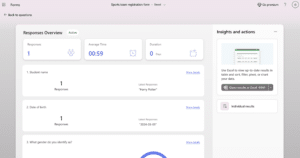
By using these built-in tools, you can efficiently collect and manage registrations without the need for additional software. However, for more complex workflows, you may need to integrate Microsoft Forms with other solutions to fully optimize the registration process.
A significant limitation of Microsoft Forms is the inability to automatically limit the number of responses or the number of participants per option. For example, if you have a class with a maximum of 10 seats, Microsoft Forms will not automatically close registrations once those seats are filled. You must manually monitor the number of registrations and close the form when the limit is reached, or remove the option yourself.
This limit can be time-consuming to manage for larger events with multiple sessions. If this feature is critical to your registration process, you may want to consider a tool like Activity Messenger, which not only closes registrations when a class is full, but also automates a waitlist.
When you run events or classes, many things can happen that force you to change your schedule or cancel a class. And they always seem to happen at the last minute. Not having the ability to send bulk SMS to specific people in a specific class can cause people to miss your email and show up to an empty room.
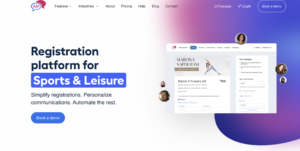
For more advanced registration needs, Activity Messenger provides a form-building tool that is designed for online registration and has all of the functionality of more complex class management software.
Here are a few reasons why you may want to consider Activity Messenger for your registration needs.
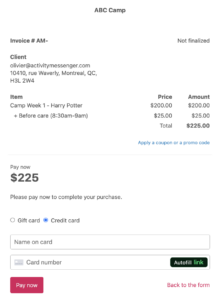
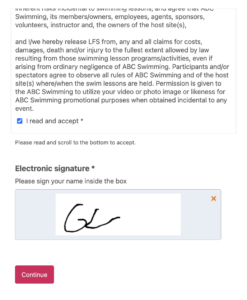





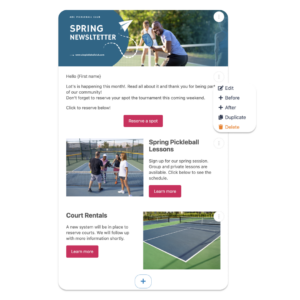
To learn more about Activity Messenger, book a demo with one of our experts.